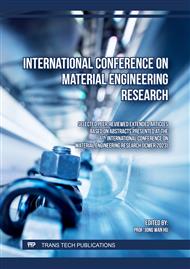[1]
K. Pacaphol and D. Aht-Ong, Preparation of hemp nanofibers from agricultural waste by mechanical defibrillation in water, Journal of Cleaner Production, 142 (2007) 1283-1295.
DOI: 10.1016/j.jclepro.2016.09.008
Google Scholar
[2]
R. Johnson, Hemp as an Agricultural Commodity,2018. Available online at. https://www.fas.org/sgp/crs/misc/RL32725.pdf
Google Scholar
[3]
A. Shahzad, Hemp fiber and its composites – a review, Journal of Composite Materials,46 (2011) 973-986.
DOI: 10.1177/0021998311413623
Google Scholar
[4]
R.E. Abraham, M.L. Verma, C.J. Barrow and M. Puri, Suitability of magnetic nanoparticle immobilised cellulases in enhancing enzymatic saccharification of pretreated hemp biomass, Biotechnology for Biofuels, 7:90 (2014) 1-12.
DOI: 10.1186/1754-6834-7-90
Google Scholar
[5]
C. Maraveas, Production of Sustainable and Biodegradable Polymers from Agricultural Waste, Polymers, 12 (2020). Retrieved from
DOI: 10.3390/polym12051127
Google Scholar
[6]
C. Zinge and B. Kandasubramanian, Nanocellulose based biodegradable polymers, European Polymer Journal, 133 (2020), 109758.
DOI: 10.1016/j.eurpolymj.2020.109758
Google Scholar
[7]
D. Klemm, E.D. Cranston, D. Fischer, M. Gama, S.A. Kedzior, D. Kralisch, F. Kramer, T. Kondo, T. Lindström, S. Nietzsche, K. Petzold-Welcke and F. Rauchfuß, Nanocellulose as a natural source for groundbreaking applications in materials science, Today's state. Materials Today, 21 (2018) 720-748.
DOI: 10.1016/j.mattod.2018.02.001
Google Scholar
[8]
I. Hongrattanavichit and D. Aht-Ong, Nanofibrillation and characterization of sugarcane bagasse agro-waste using water-based steam explosion and high-pressure homogenization, Journal of Cleaner Production, 277(2020) 123471.
DOI: 10.1016/j.jclepro.2020.123471
Google Scholar
[9]
C. Suksri and D. Aht-Ong, Preparation of cellulose nanofibers from cassava pulp residue by mechanical defibrillation, Journal of Physics: Conference Series, 2175(2022) 012039.
DOI: 10.1088/1742-6596/2175/1/012039
Google Scholar
[10]
S.H. Sung, Y. Chang and J. Han, Development of polylactic acid nanocomposite films reinforced with cellulose nanocrystals derived from coffee silverskin, Carbohydrate Polymers, 169(2017) 495-503.
DOI: 10.1016/j.carbpol.2017.04.037
Google Scholar
[11]
D. Dai, M. Fan, Characteristic and Performance of Elementary Hemp Fibre, Materials Sciences and Applications, 1(2010)336-342.
DOI: 10.4236/msa.2010.16049
Google Scholar
[12]
J.T. Mhlongo, Y. Nuapia, M.M. Motsa, T.O. Mahlangu, A. Etale, Green chemistry approaches for extraction of cellulose nanofibers (CNFs): A comparison of mineral and organic acids, 62 (2022) S57-S62.
DOI: 10.1016/j.matpr.2022.02.088
Google Scholar
[13]
D. Tian, R. P. Chandra, J. Lee, C. Lu, J. N. Saddler, A comparison of various lignin-extraction methods to enhance the accessibility and ease of enzymatic hydrolysis of the cellulosic component of steam-pretreat poplar, Biotechnology and biofuels.
DOI: 10.1186/s13068-017-0846-5
Google Scholar



